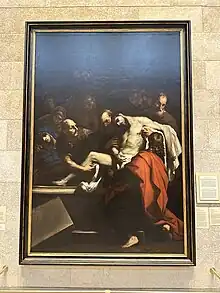
The Entombment is a c. 1650-1653 painting by6 Luca Giordano that shows the New Testament scene of Jesus Christ being placed into his tomb. It depicts the Bible's New Testament event which occurred after the crucifixion of Christ In the painting, Joesph of Arimathea holds his body from his back and Nicodemus holds Jesus'a legs up placing them into the stone tomb.
The painting includes John the Evangelist, who is clothed in red, and Mary, Jesus's mother, who is clothed in a warm blue.[1] She is deeply sorrowed by the death of her son and is being comforted by the Holy Women around her. Jesus was very important these individuals and they are all trying to process what they are seeing. Giordano places them into the foreground of the painting to show their significance in Jesus's life. There are human figures in the background of the painting that are grieving and who are discussing the scene in front of them.
Artist
Giordano is one of the most renowned artists in Naples which is one of the capitals for European art and was highly praised for his work during the 17th century. Giordano's nickname was "Luca fa presto" because he created his paintings at such a fast pace and the results were still extraordinary and well painted. [2]Giordano's catholic approach was manifested in his steadfast belief in the theory of modes, a concept that profoundly shaped the poetry and aesthetic concepts of the Seicento period. Embracing naturalism as a cornerstone of his style, Giordano's paintings exuded a distinctive spiritual essence that showcased his devout beliefs. This approach not only brought out the best in his works but also solidified his position as an exceptional artist. "The Entombment," a testament to his naturalistic technique, highlights the fusion of emotional intensity and skillful execution for which Giordano was highly revered. Oreste's insights in his book further elucidate the significance of Giordano's Catholic inclination, underscoring its pivotal role in shaping the religious thematic essence of his artistic creations.
Influence
Giordano was influenced deeply influenced by Michelangelo Caravaggio's painting of "The Entombment" and created the same painting in his own style. Giordano's first master was Jusepe de Ribera who was deeply influenced by Caravinggo's naturalism and he helped teach Giordano how to utilize naturalism in his work, as he used it in "The Entombment".[3] Giordano also studied lots of Venetian artists in the 16th century because he was captivated by luminaries of their paintings.[4] He was inspired by their use of light, color, movement, and bravura which he then applied in many of his paintings in a unique way. Several elements within the Detroit painting bear witness to the significant influence of Rubens' art on Giordano. These include the overall luminous quality, the use of vivid colors, particularly reddish flesh-tones, deep reds, bluish-greens, and occasional yellow accents on the garments, as well as the seamless fluidity in the transitions between different tonalities.
Related paintings
During the initial phase of his career, Giordano created multiple renditions of "The Entombment". The "Bari version",[5] is described as modest in quality and significantly affected by its poor state of preservation. Its historical significance was minimal until the discovery of the Detroit Entombment in 1972. The rediscovery of the magnificent Detroit Entombment solidly demotes the Bari rendition to the status of a mere replica. Nonetheless, the existence of this replica signifies the widespread admiration for this specific interpretation of a theme that held significance in the Seicento era, particularly in regions of Europe where Counter-Reformation religious beliefs endured. Giordano painted various different versions of this theme. [4] The versions found in the Museo del Sannio at Benevento and the Philbrook Art Center in Tulsa belong to a slightly later period but still exhibit distinct naturalistic features. The previous paintings of "The Entombment" are not identifiable to the Detroit version.
The Detroit Entombment
The Detroit Entombment vividly demonstrates Giordano's exceptional skill in seamlessly incorporating and blending various stylistic approaches, showcasing his remarkable versatility and artistic mastery. The figures are arranged in a diagonal form with a very low viewpoint. There is a tiered marble pedestal, which represents the tomb they are placing Jesus into. These elements reflect the typical composition seen in Venetian paintings of the Seicento. Additionally, the dramatic portrayal of the soldier's ancient attire, his facial expression, and the skillful rendering of light on his shoulder and arm illustrate Giordano's profound assimilation of Paolo Veronese's painting techniques. There are detailed naturalistic aspects in this painting which help give the painting a dramatic feel to it, the way Christ's body is positioned and how his head falls back into the shadow's of the painting, the depiction of his tortured feet in the forefront, the apostle's hand grasping the cloth, and the unidealized portrayal of the man's face, accentuated with minimal light and shadow.
See also
Bibliography
- “MAG Collection - the Entombment.” n.d. Magart.rochester.edu. Accessed December 12, 2023. https://magart.rochester.edu/objects-1/info/13366.[1]
- Ettrick), Francis Napier (Baron Napier and. 1855. Notes on Modern Painting at Naples. Google Books. J.W. Parker. https://books.google.com/books?hl=en&lr=&id=SwDAAAAQAAJ&oi=fnd&pg=PA1&dq=Painting+in+Naples&ots=4T9q0GjvhD&sig=sTeEq43xcOec_Iuev8m6i5Ztan4#v=onepage&q=Giordano&f=false.[2]
- GLEN, THOMAS L. “Rubens after Caravaggio: The ‘Entombment.’” RACAR: Revue d’art Canadienne / Canadian Art Review 15, no. 1 (1988): 19–22. http://www.jstor.org/stable/42630378.[3]
- Ferrari, Oreste. “THE ‘ENTOMBMENT’: A YOUTHFUL WORK BY LUCA GIORDANO.” Bulletin of the Detroit Institute of Arts 54, no. 1 (1975): 24–32. http://www.jstor.org/stable/41504555.[4]
- “Entombment of Christ | Detroit Institute of Arts Museum.” Dia.org, dia.org/collection/entombment-christ-45978. Accessed 12 Dec. 2023.[5]
References
- 1 2 "MAG Collection - The Entombment". magart.rochester.edu. Retrieved 2023-12-12.
- 1 2 Ettrick), Francis Napier (Baron Napier and (1855). Notes on Modern Painting at Naples. J.W. Parker.
- 1 2 Glen, Thomas L. (1988). "Rubens after Caravaggio: The "Entombment"". RACAR: revue d'art canadienne / Canadian Art Review. 15 (1): 19–22. ISSN 0315-9906.
- 1 2 3 Ferrari, Oreste (1975). "The "Entombment": A Youthful Work by Luca Giordano". Bulletin of the Detroit Institute of Arts. 54 (1): 24–32. ISSN 0011-9636.
- 1 2 "Entombment of Christ | Detroit Institute of Arts Museum". dia.org. Retrieved 2023-12-12.